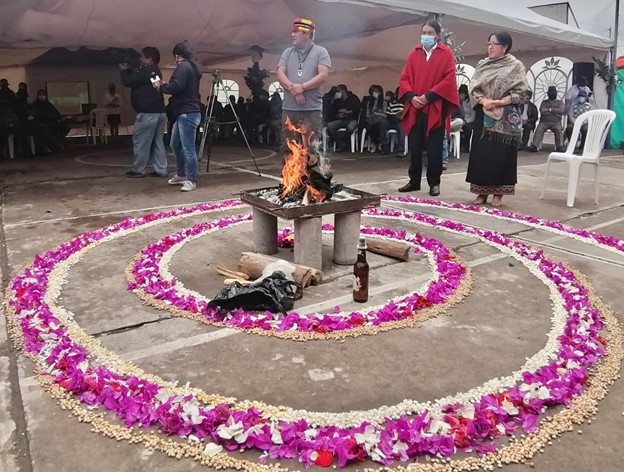by TRISTAN PARTRIDGE

The community meeting house in San Isidro, in Ecuador’s central Andes, had been specially decorated for an important occasion. On the outside wall hung a large rainbow banner celebrating the regional Indigenous organization, MICC (Movimiento Indígena y Campesino de Cotopaxi). On the ground outside, an open fire crackled at the center of a ceremonial spiral of bright purple flowers. The occasion: a meeting with leaders from the national Indigenous Movement, CONAIE (Confederación de Nacionalidades Indígenas del Ecuador).
On the agenda: strategies for how Indigenous communities across the country can collaborate to protect sacred landscapes and defend collective rights – work that people in San Isidro have been engaged with for a long time. Two days later, on Friday 20 November, they celebrated a milestone in their campaign and an important victory for Indigenous environmental activism nationwide.
Following years of organizing and campaigning, the Regional Director of the national Ministry for the Environment & Water confirmed the community’s request: land that they own collectively is now formally recognized as a national Protected Hydrological Area (APH). This not only offers new levels of legal recourse, it also creates a model for other communities to follow — in the much-needed protection of unique ecosystems.
San Isidro residents have worked tirelessly to conserve an area covering 1071 hectares of the high-altitude páramo hills. A wetland ecosystem found only in the moorlands of the northern Andes, the páramo is of great importance — both locally within the hydrological cycle and globally in terms of climate change. By absorbing rainfall, filtering the water and then gradually releasing it into countless streams and rivers, páramo lands are estimated to be the origin for 85% of the water used across Ecuador for drinking, hydroelectric power systems, and agricultural irrigation. Recent studies have also confirmed the global impacts of a healthy páramo — acting as a carbon sink and thus helping to regulate broader climate patterns.
Toward Freedom for more
